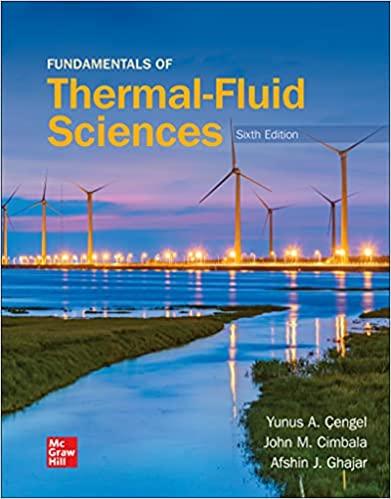Question
After a heat treatment process, a thin cast iron plate of thickness =8 mm, length L=2 m and width W=0.5 m is cooled down by
After a heat treatment process, a thin cast iron plate of thickness =8 mm, length L=2 m and width W=0.5 m is cooled down by forced convection. To this end, the plate is suspended (see figure below) and air, with free stream temperature T_=25 C, is circulated at v_=25 m/s. The air flows in the direction of the longer side of the plate (see figure below). The plate has initial temperature of T_i=400 C. Assumptions: Neglect radiation; the plate is suspended in air thus both sides are swept by the stream of air; the regime starts laminar at the beginning of the plate.

Data:
Cast Iron plate: kmetal = 60WmK, cmetal=250 Jkg K, metal=5000kgm3
Air: air = 15.8910-6m2s, kair = 0.0263WmK, Prair = 0.707
Please answer the following questions; if you make any additional assumptions, please clearly indicate them in your answer(s).
1. List all the steps needed for calculating the average convective heat transport coefficient (ho).
2. Is the regime laminar, mixed, or turbulent? Sketch the momentum boundary layer and the thermal boundary layer (it is enough to do it only on one side of the plate).
3. Calculate the average convective heat transport coefficient (ho) considering the plate at its initial temperature. Calculate the heat flow when the plate is at its initial temperature.
4. If the plate were suspended vertically instead of horizontally (from the long side: i.e. the air was flowing in the direction of the short side of the plate) would the average heat transfer coefficient be smaller, equal, or the same? Please provide a short explanation (only two or three sentences).
5. Calculate the time needed for the outer surface of the plate to be 50 C. Please use the heat transport coefficient calculated in C.
6. At the time calculated in E, what will the temperature of the center of the plate (at half thickness) be? Please provide a short explanation (approx. two or three sentences).
7. Still ignoring radiation, is the time calculated in E an overestimation or underestimation of the real time need for the object to cool down to the target temperature? Please provide a short explanation (approx. two or three sentences).
8. How the calculations in E would change if you were to account for the radiation effects? Please provide a short explanation (approx. two or three sentences).
Step by Step Solution
There are 3 Steps involved in it
Step: 1

Get Instant Access to Expert-Tailored Solutions
See step-by-step solutions with expert insights and AI powered tools for academic success
Step: 2

Step: 3

Ace Your Homework with AI
Get the answers you need in no time with our AI-driven, step-by-step assistance
Get Started


